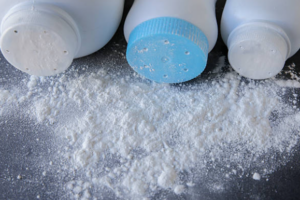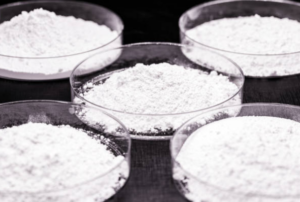Cosmetic Alchemy

In the enchanting world of beauty, where colors swirl and pigments dance, there lies an often overlooked ingredient with a controversial tale – talc. Talc has been a mainstay in the cosmetics industry for decades, praised for its silky texture and oil-absorbing properties. However, as the pages of beauty unfold, so does the untold story of talc, revealing potential risks and concerns associated with its use in makeup. Join us in the exploration of “The Hidden Tale,” as we unveil the darker side of talc in your makeup and discuss why awareness is crucial for conscious beauty choices.
Talc, derived from the mineral talcum, has long been cherished in cosmetics for its ability to absorb moisture, provide a smooth texture, and enhance the application of makeup. Its finely milled nature gives products, particularly powders, a luxurious and velvety feel. Talc’s presence is pervasive, gracing countless eyeshadows, blushes, and setting powders, earning its reputation as a staple in the beauty industry.
The Concerns: Talc and Asbestos
The controversy surrounding talc is intrinsically tied to the potential presence of asbestos, a naturally occurring mineral known for its carcinogenic properties. As talc is often mined from deposits that can be interwoven with asbestos, there is a risk of cross-contamination during the extraction process. The fear lies in the inhalation or ingestion of talc particles contaminated with asbestos, which poses potential health risks.
Talc and Ovarian Cancer: A Debated Connection
A longstanding and contentious debate revolves around the possible link between talc use in the genital area and an increased risk of ovarian cancer. Some studies suggest a correlation, while others find inconclusive evidence. The controversy has led to legal battles and raised concerns among consumers about the safety of talc-containing products, especially those intended for feminine hygiene.
Respiratory Risks: The Powdered Peril
One of the inherent dangers associated with talc lies in its finely ground nature, making it susceptible to becoming airborne. When talc-containing products are applied as powders, there is a risk of inhalation. Prolonged inhalation of talc particles has been linked to respiratory issues, including inflammation, coughing, and, in extreme cases, the development of respiratory diseases.
Regulatory Oversight and Challenges
While regulatory bodies, such as the U.S. Food and Drug Administration (FDA) and the European Union, set limits for asbestos in talc, ensuring the safety of talc-based products remains a complex challenge. The voluntary nature of testing and the reliance on self-regulation within the cosmetics industry raise concerns about the adequacy of oversight and transparency.

The Shift to Talc-Free Alternatives
In response to growing consumer awareness and concerns, the beauty industry has witnessed a notable shift towards talc-free formulations. Many brands are opting for alternative ingredients like cornstarch, rice powder, or mica to maintain the desirable properties of talc without the associated risks. Talc-free products are now increasingly prevalent, providing consumers with safer choices.
Navigating the Labels: A Consumer’s Dilemma
For consumers, navigating the labyrinth of ingredient labels can be daunting. The use of ambiguous terms like “fragrance” or “parfum” to protect proprietary formulations adds another layer of complexity. To make informed choices, it is crucial for consumers to educate themselves, scrutinize ingredient lists, and choose brands committed to transparency and safety.
Advocacy for Transparency and Accountability
The call for transparency and accountability within the cosmetics industry is growing louder. Advocacy groups, health organizations, and concerned individuals are pushing for stricter regulations, mandatory testing, and clearer labeling. As consumers demand safer alternatives, the industry is compelled to respond, ushering in an era where beauty is synonymous with both glamour and responsibility.
Safer Choices: Embracing a Conscious Beauty Routine
In the quest for safer beauty practices, consumers are encouraged to embrace a conscious beauty routine. This involves choosing products from brands that prioritize transparency, undergo rigorous testing, and formulate with integrity. Talc-free alternatives, enriched with natural and responsibly sourced ingredients, offer a pathway to beauty that doesn’t compromise health.
The Power of Informed Choices
As the beauty narrative unfolds, the power of informed choices becomes apparent. By understanding the potential risks associated with talc in makeup, consumers can make decisions that align with their values and prioritize their well-being. From supporting brands committed to safety to advocating for stronger regulations, every informed choice contributes to reshaping the beauty landscape.
“The Hidden Tale” invites us to reconsider the narrative surrounding talc in our makeup. Beyond its silky allure lies a story of potential risks and concerns that demand our attention. In the pursuit of beauty, it is our right and responsibility to be informed, to question, and to choose consciously. As the beauty industry undergoes a transformation towards greater transparency and accountability, let our choices reflect not only our desire for glamour but also our commitment to a beauty that is safe, conscious, and empowering.

